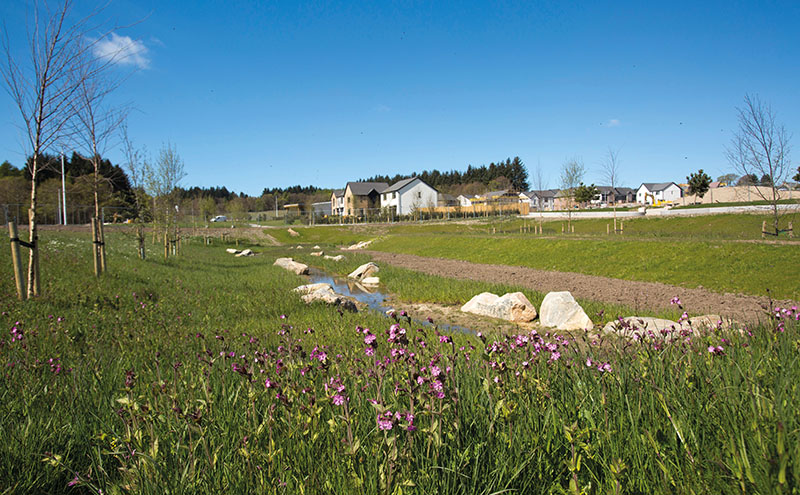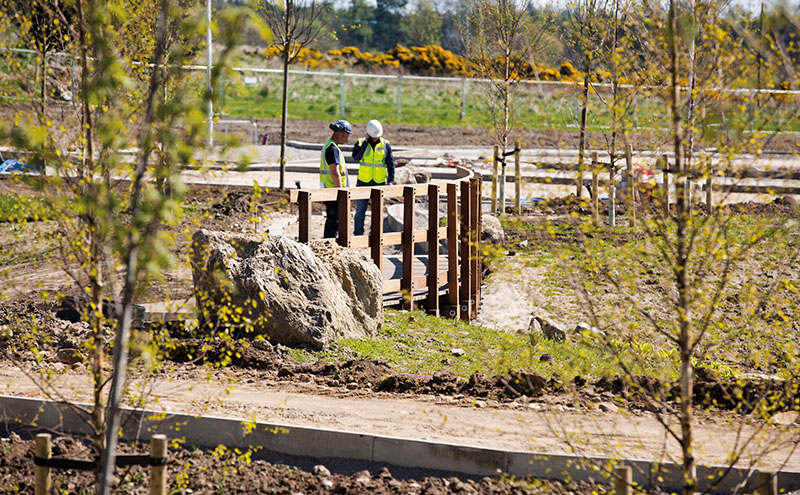
COUNTESSWELLS, a unique new community to the west of Aberdeen, is starting to take shape with the first residents now in their homes.
When complete, the development will feature some 3,000 homes, including 750 affordable homes, which are being phased in over a 15-year period.
Countesswells will also contain three schools, healthcare facilities, shops, business spaces, leisure facilities, parks and open spaces.
The £800 million development has been described as an exemplary project and is tipped to provide a model that could be repeated in other parts of the country.
Around 1,000 construction jobs will be supported by the project, mainly from the local area.
Countesswells Development Limited (CDL), a wholly owned subsidiary of Stewart Milne Group, is delivering the community.
CDL recently announced that Allan McGregor, formerly project manager for the development, was replacing Jim Fitzsimons as project director.
Allan joined the Countesswells team last year, having previously worked in public and private development management with Robertson Group and Morgan Sindall Group.
He told Project Scotland that the Countesswells development has been on the go since the 1980s in terms of an idea and aspiration to create something.
“It’s going to run for another perhaps ten to fifteen years depending on how we roll out different phases and respond to changes in the market,” he said. “But the vision and the plan is there; it’s all formulated, structured and you’re looking at creating something that could have around 3000 homes, two primary schools, a secondary school, neighbourhood centres, big parkland settings and potentially a population of 7000/8000 people.
“It’s a huge undertaking when you look at it in the short-term but we’re looking at 10-15 years worth of work, which we’ll phase in over a period of time.
“I dare say it will probably set the model for others. What is slightly different about this model though is that we have a Treasury-backed guarantee. The Treasury has underwritten a covenant on this project to support its delivery. That’s quite unique in its own right. As far as I’m aware, there is no other housebuilding development or new community that’s been underwritten by the Treasury, so this is unique not just in Scotland but the UK.”

Allan added that the planning and design aspect of the project got underway around four years ago. Physically, the actual building of the first phase started a year ago and is now nearing completion. A huge amount of construction work has taken place in the last 12 months to get to a point where the first families are moving in.
“We had to bring in a lot of heavy infrastructure to serve the site,” Allan said. “It’s essentially a big greenfield site to the west of Aberdeen that has been arable farmland for centuries almost.
“It’s very unconnected from the grid; there’s no gas, drainage systems don’t really exist, communications systems don’t exist. We’ve had to connect all of the land up bringing in the heavy utilities. We’ve brought them in from quite substantial distances. We’re almost up 2.5 kilometres from the site. We’ve been bringing in gas and communications from the north and power and drainage from the east. That’s taken the best part of a year. In conjunction with that we’ve been formulating and building the first road infrastructure around the development.
“The first phase of the development is almost a ‘figure of eight’ primary road network that allows us to then open parts of the land up for development by the housebuilders. Woven through that is the sustainable element and the environmental element, which is really the parkland setting. We’re creating a huge parkland area; we’re taking old drainage ditches, which are loosely termed ‘burns’, and turning them into a more naturalised burn with gentle sloping banks, cascades, waterfalls, bridges going over the burn channel and really turning it into an environment that people can enjoy and live in. It will encourage wildlife and more ecological aspects. That’s been pretty much the first year in terms of the core setting up of the development.
“What it has allowed us to do is open up the first site for housebuilding, which commenced in late August last year. In that period of while we’ve been bringing in the heavy infrastructure, we have managed to build a few homes and we’ve now got families living on the development who are enjoying what is now nearly a complete part of the first phase of amenity in that area.”

The first road excavation commenced on May 3, 2016. By March 31 this year, people were living in the community.
The project ties in with the overall development plan set by the council based on Aberdeen population growth estimates.
“To service that increase they need X amount of houses, which will be distributed between Aberdeen and Aberdeenshire,” Allan explained. “That is drawn into a development plan and we are supporting that. This area was already identified as an area for a new community to be born. It should be distinct; it’s not there to challenge the other communities that are surrounding the site but it is quite a distinct environment in the setting that it occupies. It’s bounded by woodland space around it. There’s still a lot of farmland around it. It’s quite a semi-rural area and we are addressing that through design and trying to maintain that feel of semi-rural environment where you’re designing houses to suit that style of living.”
Most of the subcontractors working on the project are from Aberdeen or the central belt. Countesswells has already brought a number of economic benefits to the area and provided a boost for the nation’s construction sector.
“There are some heavyweight projects up in Aberdeen at the moment so there is a fair demand for resources in the area,” Allan said. “We’ve got some information back from our subcontractors that they are either taking on new apprentices or they’re maintaining apprenticeships.
“Also, there’s a secondary effect to that where you’ve got the supply market for the businesses that are slightly remote from the construction element, whether it’s food-related or construction materials-related or even hotels. It has an impact on supporting the local economy and keeping hotel rooms occupied. I suppose it’s in contrast to what’s going on in Aberdeen where you’ve got a slight downturn with the oil and gas (sectors) whilst construction is still moving forward. We’ve got big projects moving forward in the area and this just happens to be one of them.”
Not surprisingly given the scale of this project, one of the biggest challenges is keeping the local communities engaged and informed. Steps have been taken to ensure the first residents won’t feel like they’re living in the middle of a building site for the next decade.
“From a technical and design point of view there are challenges we address through a level of consultants we employ,” Allan said. “The wider impact we have is trying to be a good neighbour and support the local economy, businesses and users that are dealing with the construction activities we have underway. Construction is a constructive business but it can be destructive at times. We do engage with residents and businesses to try and manage the effects of what we’re doing. We are competing in an area where there are large projects underway at the same time not too far from our doorstep.
“While they’re all great for the local economy, there are challenges to be had where you’re managing traffic flow, for example, which is always a big issue no matter what scale of project you’re dealing with.
“We’ve had a few years of community engagement. We have a liaison officer and we’ve got mechanisms in place where we communicate via e-mail, social media and face to face or we host events or get invited along to events by local councillors or certain bodies to explain what we’re doing or to demonstrate what we’re doing whether it’s to do with traffic management or what the future development is going to look like and we do it across different levels.
“If someone’s living on the doorstep of the construction site maybe it’s not to their best liking but we go out of our way to manage that and we have more often than not proactive, constructive engagement with people. We don’t hide behind an e-mail address and say we’ll get back to you in X amount of time; we do go and meet and greet and have one to ones.”
Allan believes Countesswells could heavily influence other developments across the UK and provide a blueprint for lively communities featuring housing of different types where families will want to put down roots.
“It’s not a case of opening up a site and start putting boxes in,” he said. “We need to create environments that people really want to live and stay within. We’re not looking at Countesswells as somewhere where people will come and go; they will be there for generations. We see them growing up, bringing in their families, perhaps their kids will go to school there, the kids will buy in the area and they will effectively retire in the area. We see it as a model that should work throughout the UK. The Treasury is quite intrigued by that because there are lots of developments that have been on going since the 1980s and before which can be soulless places; they’re a bit dislocated and unconnected. This is all about trying to create something that’s a bit more connected and has a unique identity that will encourage people to stay.”
One of the most interesting aspects of Countesswells is the fact that a lot of the infrastructure and green spaces have been brought in at the outset of the project, with housebuilding following on later. Allan said, “Creating the parkland setting and the amenity up front and bringing in all the infrastructure, which is an investment of just over £15 million, is that before we’ve even dealt with any house sales or selling any product through a housebuilder, we’ve invested that money up front to create the environment so that when people do move into the area, they have that access straightaway. They’ve got the parks, they’ve got the trees, they’ve got the stuff that makes life worth living. They don’t have to wait five years; they’ve got it almost from day one.
“From my own experience, normally a developer might open up a site, start cutting his way into it, build a few houses, sell a few houses, the construction then proceeds in behind those houses and then for maybe two or three years you might have that builder trundling by the front door of the first occupied houses. We’re doing it slightly differently. We’ve analysed a lot of things to do with construction vehicle movement, for example, so we’re looking at creating a back of house side to this development so that when we open up the public side of the development to people and families living in the area, the two trains don’t really connect.
“We’ll keep the construction activity as far away from the people now living in the area so that they get the most out of the environment that they’ve invested in.
“Don’t get me wrong, you do get conflicts with that type of approach but to actually set it up in the first place takes a fair bit of planning and investment just to create the space, width and the environment so that you can segregate construction from occupation as such.”
Allan was delighted to see the first families moving in, helping bring to life a project that has been many years in the making. More milestones are expected before the end of the year.
“Now that we’re coming into summer, we’re starting to see the area mature up,” he said. “It seems to be a great place to be. We’re still going through a transition as we bring that first phase to an end, which will be around the end of June. Then we will spend another two years managing the establishment of that green space. We’ve got a long-term commitment to make sure the green space comes through and is established well. We wouldn’t let a contractor come in, put a couple of trees down and then walk away from the job. We’re managing that for a long period of time because we recognise that nature takes time to take a hold and we are trying to create an ecological environment alongside our long-term infrastructure development.
“We’ve hit quite a few milestones. On St Andrew’s Day we planted the first of 600 trees. Conveniently, by St Patrick’s Day this year, we had cherry blossom growing on these trees. Our next big milestone will be completion of the phase one infrastructure, which is the heavy engineering, which is not too far from being complete.
“At the same time we will bring a lot of the soft landscaping to a conclusion but we will be back in October to plant more trees. We’ve got about 400 trees in the ground at the moment so there are another 200 to go. We’ve built an orchard, which is basically formed from a lot of recovered stone from the site. It’s quite a sustainable approach to this project. We recycled the stone, protected it, looked after it and we’re now re-integrating it back into the landscape through garden walls or stone feature walls. We’re engraving some of the lintels with the Countesswells logo and using that to create the permanent features. The orchard will effectively be a community orchard; it’s there for people who live in the area to take ownership of and enjoy.”










